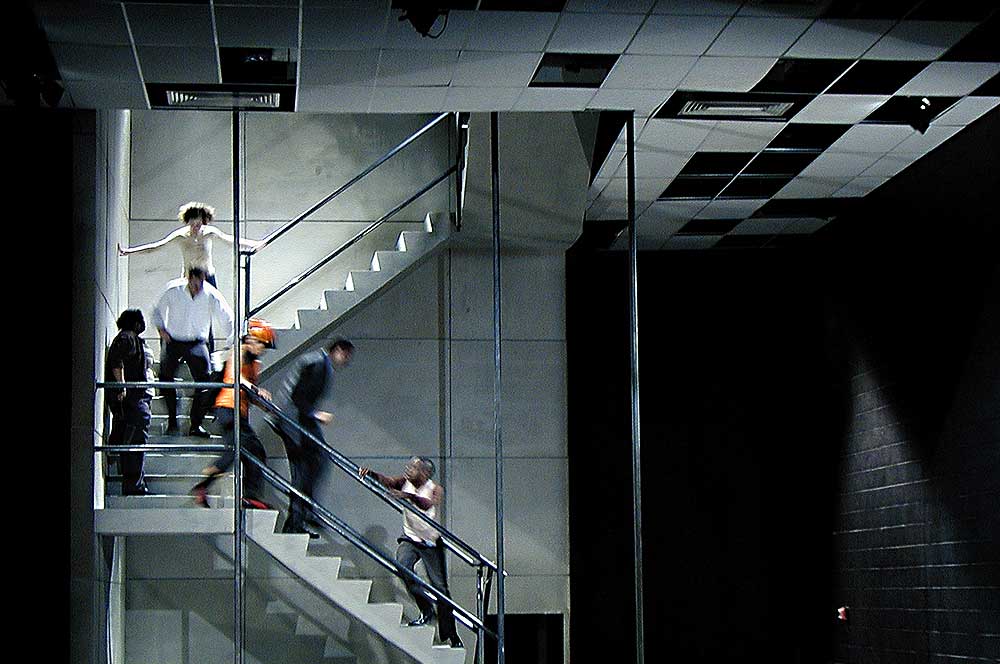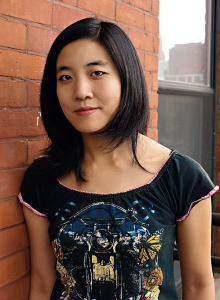 Mimi Lien’s first theatre design job was an olfactory disaster.
Mimi Lien’s first theatre design job was an olfactory disaster.
The show was an undergraduate production of Jean Genet’s The Maids, and the show’s director had a vision. “It was decided that the entire floor of the set was to be covered in rose petals,” Lien recalled recently, when asked to think back on the high and low points of her career as an award-winning set designer. “So I called up a company in the flower district in New York and found out they provided rose petals for potpourri. I figured I needed two cases for the job, and they asked me, ‘Scented or unscented?’
“And I was like, ‘Hmmm…,’” she continued, laughing. “That hadn’t occurred to me, but I liked the idea of an olfactory element to the design, so I told them, ‘One of each.’”
As artistic choices go, it wasn’t one of Lien’s best. “It was not even a scent,” she declared with a roll of her eyes. “It was a stench of roses! I literally got sick from the smell—it was in my clothes, in my hair.” Needless to say, the play’s cast felt nose-deep in character.
Lien, a native of Connecticut, came to theatre late. She studied architecture at Yale, where, despite the prominence of the drama school, she rarely attended plays or involved herself in theatre (notwithstanding that early misadventure with The Maids). After completing her undergraduate degree, she went to study painting in Florence, Italy, which she intended as a break before returning to graduate school in architecture. The two-dimensional mode of painting ultimately didn’t suit her, though, and at the suggestion of a teacher, she decided to look into scenography as a field that could combine her interest in the use of space and her passion for the visual arts.
It was a good call. Today Lien, 38, is one of the most sought-after set designers in New York, and her work will be seen this fall on stages from Los Angeles to Chicago to Brooklyn.
Ranging from ballet to regional theatre and Off Broadway to experimental site-specific performance, Lien has developed a reputation for being able to solve complex problems with visually arresting designs. Her work for Dave Malloy’s immersive musical Natasha, Pierre and the Great Comet of 1812 won her both a Lucille Lortel Award and a Henry Hewes Design Award, for a run that originated in a small black box theatre before transferring to a commercial run in a circus tent in Lower Manhattan and later Times Square.
“Because she trained as an architect, she has this amazing sense of volume,” says her colleague Dan Rothenberg, a Philadelphia-based director, “and that’s where I feel Mimi’s poetry resides. There’s this very basic problem in all spatial design of volumes and proportions, linearly and in space, and she just has a feel for that particular problem.”
Lien and Rothenberg first collaborated nearly a decade ago, when Lien was hired to design the set for Love Unpunished, a devised piece created by Pig Iron, the celebrated experimental troupe that Rothenberg co-founded in 1995 (and which Lien later joined as an associate artist). Set in an abandoned theatre, the piece was conceived as a response to the trauma of the 9/11 attacks. Out of deference to the tragedy, the company began imagining the performance as movement-based rather than relying on text, and Lien was invited in to solve the problem of grappling with a huge amount of space. Her design, which was ultimately featured in the Prague Quadrennial, the internationally regarded showcase for theatre and performance design, consisted of massive concrete staircases mounted to the wall, which performers would walk up and down in silence.
“The space where the performance is taking place and that the set is going into is pretty key to me,” Lien told me of her process. “That’s ground zero, so to speak. I don’t want to start designing anything until I spend some time sitting in the place.”
Lien’s process is particular and exacting. While there may be sketches early on, she generally works in three dimensions, creating detailed models to bring to design discussions. Rothenberg mentioned numerous different configurations for Love Unpunished that Lien prepared for comparison before they arrived at the right solution. In fact, she’s so wedded to building models that she says her No. 1 rule is “never to dismantle a model to make changes,” but rather to start from scratch.
“It may seem easier at the moment to just revise the model piece you’ve been working on,” she commented, based on years of experience, “but then you may find a week later that the first version you made had something good about it—and now you can’t figure out how to get back to it. The first attempt at making something is really important to keep around, because it’s the purest impulse.”
Indeed, the visual and the tactile are her anchors. A big part of her research process is spending time in the library, particularly in the picture collection of the Mid-Manhattan New York Public Library—“Not the nice, main New York Public Library on 5th Avenue,” she explained, “but this ugly building across the street that was built in the ’60s.
“There’s one room on the third floor—it’s probably 30 feet by 40 feet—that’s filled with shelves, and all the shelves are filled with accordion folders that are filled with pictures mounted on card stock,” she noted. “Pictures a person actually had to cut out from a book or a magazine and paste on a card and catalog and file away.”
Acknowledging her own Luddite tendencies, Lien explained that she found it a better way to work—going down rabbit holes in search of visual inspiration using an old cataloguing system, rather than Google Image Search. She prefers laying out various and sundry pictures on a table and arranging them in search of information.
It was this process that actually helped her come up with the lauded design for The Great Comet, an “electropop opera” composed by Dave Malloy and directed by Obie winner Rachel Chavkin. Before it made its way to a commercial Off-Broadway run in 2013, the show premiered in humbler circumstances at the small but adventurous Ars Nova in 2012. After speaking with Chavkin and Malloy about designing the show, she attended an early workshop in the space.
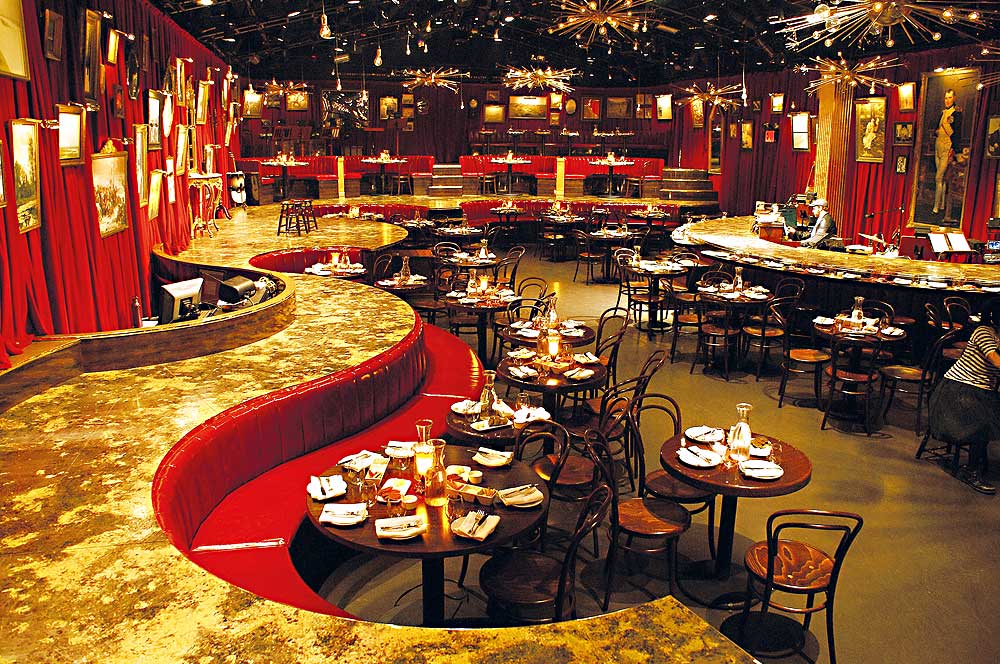
“Ars Nova is set up like a cabaret, with tables and chairs—I sat at one of the tables in the far corner. The primary playing area wound up being in the center and on the floor, whereas the audience was sort of raised up on little terraced areas, and I found that it was really hard to see. I felt like I had to come up with a way to help that situation.”
Back at the Mid-Manhattan library, she started looking at photos of supper clubs and nightspots, and arrived quickly at the design concept that profoundly influenced the show. “I noticed that when people sit in booths, there’s often this flat area behind them at shoulder level, and I went, ‘Aha!’” Drawing inspiration from her experience assisting designer George Tsypin, who helped expose her to Russian ornamental design, Lien concocted a massive, serpentine, raised set that snaked its way among audience members seated at tables, who were forced to turn and actively follow the performers as they moved among and around them.
The concept was ambitious in terms of budget for the initial production at Ars Nova, and, mindful of that, Lien prepared several cheaper and easier-to-implement designs based on her initial inspiration—but, as Chavkin recalled, none of them approached the power of the original. Additional funding was acquired, and the entire staff was put to work finding recycled materials and props to implement one of the most ambitious designs Ars Nova had ever pulled off. This ultimately played a role in earning the interest of commercial producers for a transfer—at which point Lien scaled up her set and also designed the lobby, dressing rooms and a catering kitchen in a large circus tent situated in a vacant lot in Manhattan’s Meatpacking District.
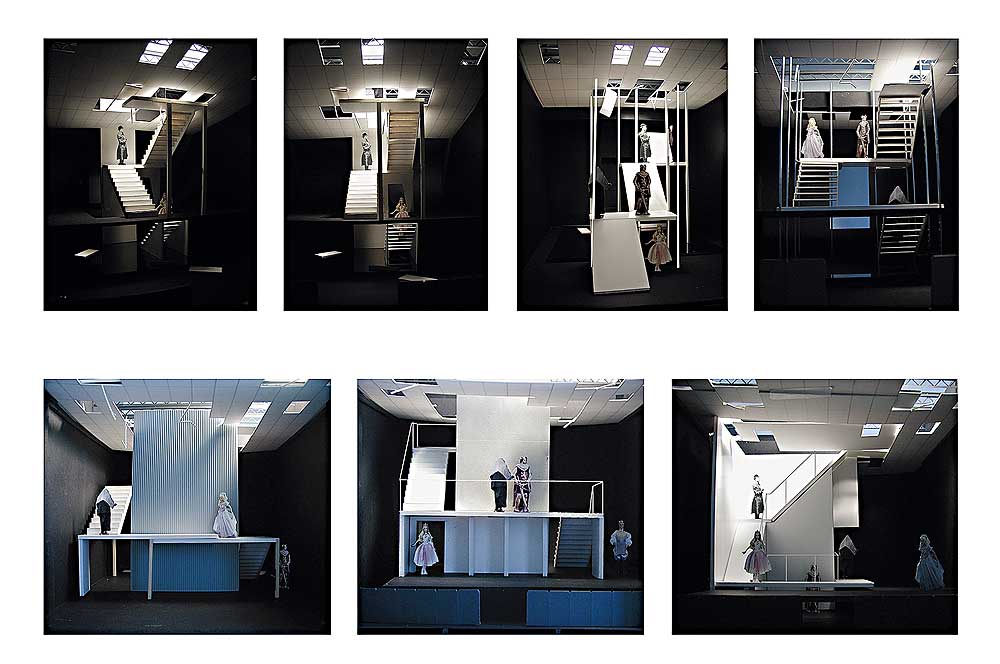
BUT LIEN HAS PROVEN herself equally adept at designing minimalist work, particularly for the plays of Toshiki Okada. A Japanese playwright and director who’s garnered international acclaim over the past decade, Okada’s was introduced to New York audiences through the 2010 production of his play Enjoy by the Play Company, a troupe dedicated to presenting new international work. The Play Company brought on Rothenberg, who was on sabbatical from Pig Iron, to direct. He, in turn, asked Lien to design.
Okada’s texts are highly minimal and abstract, and actors rarely perform in character—they’re more likely to tell stories about each other, occasionally slipping in and out of scenes in which they interact. Okada’s own productions usually feature little more than geometric lighting projections which slowly unfold around the actors.
“Okada described what he wants to do this way: ‘I don’t want to create the image onstage—I want it to be in the actor’s head, and find the most direct way to put that into the audience’s mind,’” Lien explains. “That may not involve creating that image onstage at all. It may actually be a combination of movement and text that creates what he calls a ‘richer image’ in the audience’s mind. What that meant to me is that I needed to create the most blank and neutral space possible. It was one of the hardest artistic design questions I’ve had to wrestle with.”
The simple negative space offered by a black-box theatre was actually not neutral enough, Lien found, so she proceeded to design sets (not just for Enjoy, but for 2012’s Zero Cost House, an Okada collaboration with Pig Iron, and Sonic Life of the Giant Tortoise, a 2014 production, once again with the Play Company) that were strikingly sterile: office spaces, boxy environments made of contemporary manufactured materials like plywood, with Ikea-esque furnishings when furniture was required.
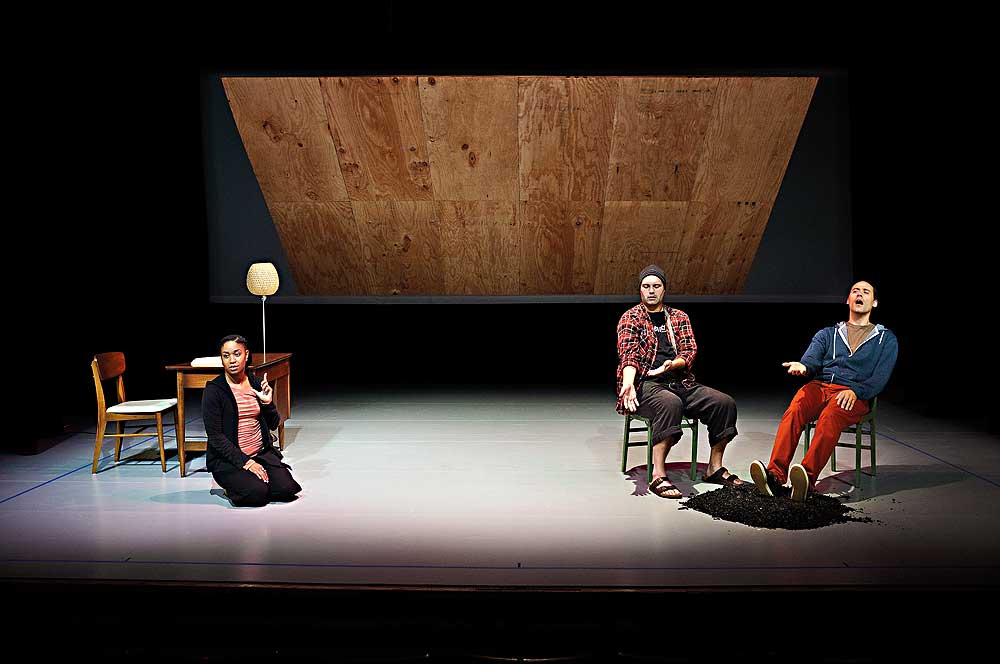
Materials are important to Lien’s work. “How it looks is really dependent on what material you use to build it,” she reasoned. “In terms of structure, there are a lot of options, but in terms of the surface, I specify exactly what it is—if it’s plastic or wood or metal.”
That rule of thumb has occasionally caused problems for Lien. Asked if she’d be willing to share a teachable moment in which something didn’t work out as intended, she laughingly detailed the problems with her set for the Civilians’ The Great Immensity. A pointed exploration of the effect of the human contribution to global climate change, that 2012 production at Kansas City Repertory Theatre—later staged at New York’s Public Theater—required a set, Lien says, that looked “massive, heavy and industrial.”
“I designed a shipping container that was installed on this other big, industrial structure, kind of like a bridge,” she recounts. In addition to capturing a sense of the titular magnitude of the play, Lien’s set was conceived to reference the leitmotif of a binary relationship that threads through the narrative, which is set in equal parts along the Equator and at the North Pole. The idea was to build a set that would rotate manually, as the Civilians couldn’t limit themselves to booking theatres with a turntable on stage. In any event, the technical director who built the initial set in 2012 took Lien’s recommendations for weight and material aesthetic to heart, and wound up producing an “insanely heavy” set that required at least eight people to manually turn it onstage, as opposed to the intended two.
“Maybe it wasn’t necessary to use actual steel I-beams,” she mused.
This fall, in a testament to Lien’s growing reputation, her work will be on stages across the country. Her set for Jordan Harrison’s Marjorie Prime can be seen through Oct. 19 at the Mark Taper Forum in Los Angeles.
In New York she’s designed a set for Sarah Ruhl’s new play The Oldest Boy, which premieres at the Lincoln Center Theater in October.
Eric Ting’s production of a new play by Frances Ya-Chu Cowhig, The World of Extreme Happiness, which opened at the Goodman Theater in Chicago in September before moving to New York’s Manhattan Theatre Club in February. The play challenges Lien to produce a set following the transformation of the main characters’ world—the massive industrialization of China over the past 30 years, as seen through the eyes of a young girl fleeing rural China for a better life in the city.
“Some designs are based on research and careful planning, and others are based on a gut feeling,” Lien said. Responding in equal parts to the contours of the stage of Lincoln Center’s Mitzi E. Newhouse Theater and the geometry of Buddhist art, Lien’s set creates a “floating aperture” raising the action of the “rituals” above the “real world” playing space below.
The idea of blurring the line between art and life increasingly informs her work. “I’ve become more and more interested in work that takes place outside of a theatre building, and is therefore able to mingle with other societal structures,” she observed. “As someone who came to theatre late in the game, I definitely feel like I have a bit of an outsider point of view—which I fully embrace.”
Jeremy M. Barker is the performance editor of Chance magazine and a contributing editor to Culturebot.org.

